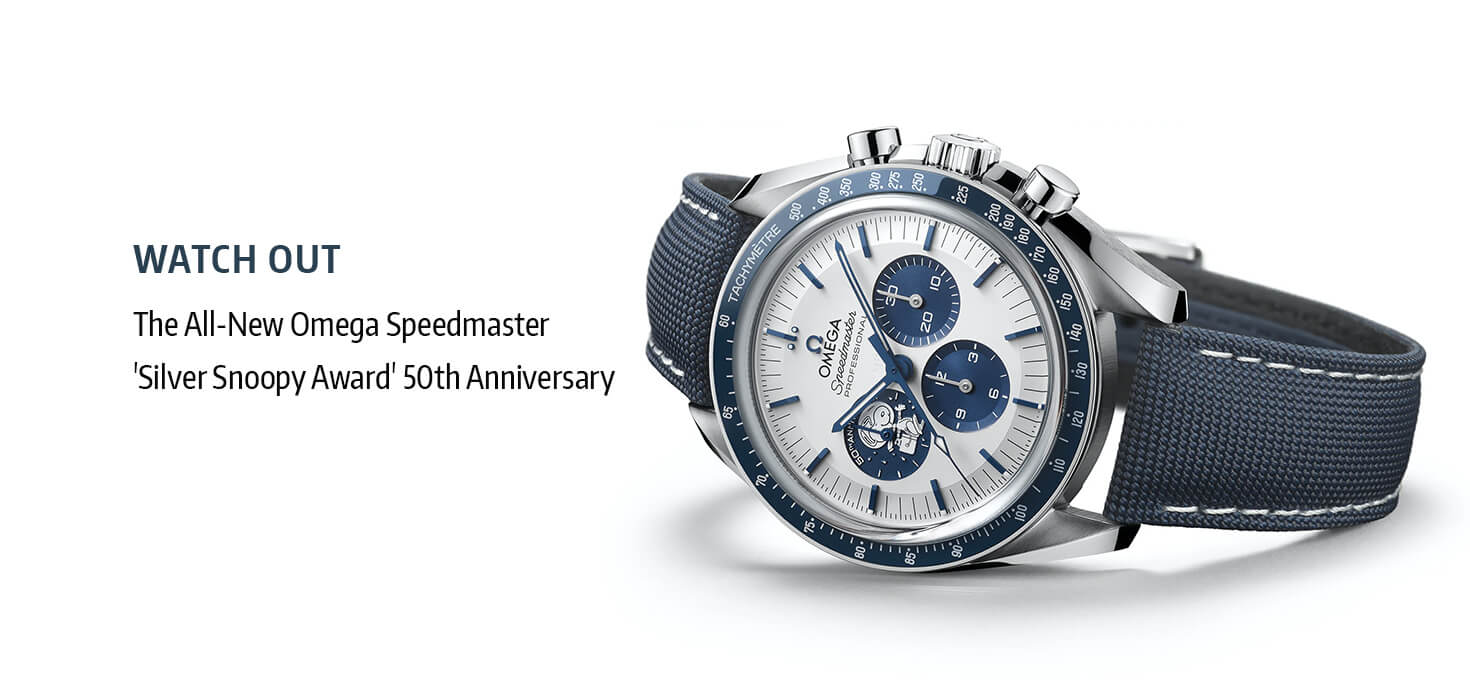Only a few brands in the world can look Omega eye-to-eye, the brand enjoys an unmatched reputation for its legacy, prestige, functionality, exceptional timekeeping accuracy and, class-apart designs. And, it is for all these factors that Omega has earned the trust of astronauts, athletes, and discerning watch connoisseurs.
From creating the world’s first minute-repeating wristwatch (developed by the founders of Omega) to introducing the co-axial escapement, Omega has continuously pushed the boundaries of innovation and it is this dedication, to stay ahead of times, that makes Omega one of the most popular luxury watch brands in the world.
While all of Omega’s brilliant collections live the brand’s heritage, each of them has an aura and opulent history of their own, and same goes for Speedmaster – The Moonwatch.
Birth of Omega Speedmaster Watch
Omega Speedmaster watch was first launched in 1957, a chronograph watch specifically designed for sports and racing enthusiasts. Originally intended for precision sports and timing races, the Speedmaster was not designed to withstand the challenges of space travel.

At the time, mechanical chronograph wristwatches were scarce, and the Speedmaster stood out as a significant departure from anything seen before. The initial model boasted a 39mm case size and introduced the first-ever engraved tachymeter scale on the bezel. It was also shockproof, antimagnetic, and quickly gained recognition as a highly capable tool watch.
The legendary Caliber 321, a movement dating back to 1942, powered the Omega Speedmaster watch. Remarkably compact with a diameter of only 27mm, the Caliber 321 remains one of the smallest and most esteemed chronographs ever manufactured.
In addition to these inventive features, it was the relentless pursuit of excellence and NASA’s rigorous testing that led to the Speedmaster’s selection as the official timepiece for space exploration and became the first watch used on the moon. Enduring extreme conditions and passing stringent tests, the Omega Speedmaster watch proved its durability, accuracy, and reliability, becoming an integral part of NASA’s Apollo missions.
Beyond its exquisite craftsmanship and precision-driven technology, this iconic watch holds a significant place in history as the first watch used on the moon.
Apollo 11 and The Moonwatch
Omega introduced the new generation of Speedmaster watches in 1962 with the release of the 105.002 model, followed by the 105.003 model in the subsequent year. NASA, in its preparation for the first moon mission, originally selected and tested the 105.003 model. Competing against watches from other renowned luxury brands, each timepiece underwent rigorous tests designed by the space agency to evaluate their reliability in extreme conditions of heat, cold, pressure, humidity, and various other trials. By March 1965, only the Omega Speedmaster had successfully withstood these tests and was chosen as the Apollo watch.
After NASA’s selection, Omega divided the product line into two categories, with the new asymmetrical case models featuring crown guards for enhanced protection becoming the Speedmaster Professionals. This meant that the extensively tested 105.003 model would not be the one sent into space. It was replaced in 1966 by the 105.012 model, measuring 42mm—a model truly deserving of the title “moonwatch.”

On July 20th, 1969, Neil Armstrong and Buzz Aldrin made history by landing on the lunar surface. Both astronauts were issued the 105.012 models, but Armstrong had to leave his watch behind in the command module as a backup for a malfunctioning electronic timer. Thus, it was Aldrin’s watch that became the first to be worn on the moon. However, little did the Apollo 11 crew know that Aldrin’s Omega Speedmaster Professional Chronograph or Apollo watch would etch its name into history as the first watch used on the moon. This groundbreaking moment not only solidified the Speedmaster’s legacy but also emphasized its unrivaled reliability and performance in the most extreme environments.

Behind the timeless aesthetics of the Omega Speedmaster lies a complex and meticulously engineered timekeeping marvel. Its intricate internal components, meticulously assembled by skilled artisans, enable precise timekeeping and smooth chronograph functionality.
The Speedmaster, until 1968, ran on the iconic Calibre 321 as its power source. However, Calibre 861 eventually replaced this movement. The Calibre 861 featured enhancements such as a high-grade rhodium-plated finish which further evolved into the more intricately adorned Calibre 1863. The present model of the Omega Moonwatch is powered by an almost identical manual-winding movement that was relied upon by NASA’s astronauts during their lunar missions.
The Moonwatch Today
Inspired by the 4th generation Omega Speedmaster watch style worn on the moon, that has been to all the six moon landings and evolved over generations.

Below are the models of Omega Moonwatch we have today:
1. OMEGA Speedmaster Moonwatch Professional
Model: Omega Speedmaster Moonwatch Professional 310.30.42.50.01.002
The current iteration of the Speedmaster Moonwatch in stainless steel embodies the essence of this collection. It is equipped with the latest calibre 3861 hand-wound movement, a DO90 bezel, step dial, and maintains the iconic asymmetrical case design reminiscent of the original Speedmaster worn during lunar missions. The timepiece also showcases a modern 42mm case size, a Hesalite crystal, and a sleek 5-link bracelet for a refined aesthetic.

● Movement: Manual Winding
● Dial: Black, Small seconds sub-dial
● Bracelet: Polished-brushed five-arched-links-per-row
2. OMEGA Speedmaster Dark Side of the Moon
Model: Speedmaster Dark Side of the Moon 311.92.44.30.01.001
The “Dark Side of the Moon” is a unique version of the Omega Moonwatch which is distinguished by its modern all-black appearance. The case is cast from a single piece of black ceramic while the bezel and dial are skillfully crafted from ceramic with brushed and polished finishes. This edition of the Speedmaster Chronograph is coveted by collectors worldwide. Engravings on the case back “APOLLO 8, DEC 1968”, “DARK SIDE OF THE MOON”, and “WE’LL SEE YOU ON THE OTHER SIDE.”

- Movement: Automatic, OMEGA Calibre 1869
- Dial: Black
- Bracelet: Perforated black leather strap with a yellow rubber interior
3. OMEGA Speedmaster Moonwatch Professional
Model: Speedmaster Moonwatch Professional 310.32.42.50.01.001
This version of the classic Omega Speedmaster watch – the Moonwatch provides an option of the nylon strap. Below are the features of this avatar of the first watch used on the moon:

● Movement: Manual Winding
● Dial: Black, Small seconds sub-dial
● Sapphire crystal glass on front and caseback
4. OMEGA Speedmaster Moonwatch Professional
Model: Speedmaster Moonwatch Professional 310.32.42.50.01.002
Adding a dimension of charm to the legendary Apollo watch or the Moonwatch is a leather strap in black, while all other features of the watch remain the same. Here are the features of this model:

● Movement: Manual Winding
● Dial: Black, Small seconds sub-dial
● Strap: Leather Strap
Symbol of Prestige
Decades after its lunar debut, the Omega Speedmaster continues to captivate luxury watch enthusiasts with its timeless appeal and impressive functionality. Owning an Omega Moonwatch is more than just a symbol of exquisite craftsmanship—it represents a connection to the grandeur of the first moon landing. The heritage, precision, and iconic design of the Speedmaster elevate it to a status reserved for the most esteemed timepieces and one of the greatest men’s watches in the world.
The Moonwatch collection is available at Kapoor Watch Company, a watch retail chain with a legacy of more than 5 decades in genuine luxury watches and their service. Kapoor Watch Company has a comprehensive collection of models from the world’s largest manufacturers of luxury watches. You can visit the website to explore the collections or browse through a store nearby.





Recent Posts
Recent Comments
Archives